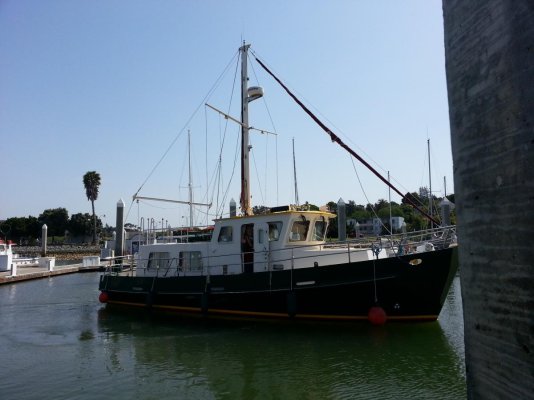If this is too long just ignore... but I'd like some advice.
Let me describe the situation. South Florida, northbound on the ICW approaching a drawbridge with a 35' height and 90' width, big bridge. I'm operating a 52' MY and require 21' clearance so I don't need an opening. I'm in a slow zone with a mild current at my stern. I'm going only fast enough to maintain control of the boat, which is slightly above idle speed. I'm monitoring Ch 16 only. I see on the other side of the bridge a roughly 30' monohull sailboat with no sails and under power about 100 yds north of the bridge, facing west, which was into the wind and broadside to the bridge, but in a wide area. He was fine where he was. When I'm about 75 yds south of the bridge, heading north, it begins to open, presumably for the sailboat. However the sailboat does not begin to turn south and remains facing west until the bridge is fully opened. Seeing that, I continue north, hugging the right (east) side of the channel which would allow ample room for both of us to pass and as I am clearing the bridge he turns and begins south from about 100 yds away. We pass port to port about 75 yds north of the bridge and then the bridgetender hails me on 16 and tells me that this is a no wake zone, that I should be monitoring Ch 9 (the bridgetender channel in Florida) and that the sailboat has the right-of way. I reply that the sailboat had not even begun his approach when I passed under the bridge and that I had done nothing wrong. He advised that the USCG monitors this channel and that I could take it up with them. I followed this up with a phone call to the bridgetender when I was back in port. He maintained he was right, that I'm required to monitor Ch 9 when in the ICW and that once the sailboat received an opening they had the right-of-way.
So, my questions are:
1) Am I required to monitor Ch9 in the ICW in Florida. I understand that I hail the bridgetender on 9 but I did not need an opening.
2) I know that a sailboat under power is a powerboat but does a boat actually get special privilege because they have an opening? There was more than enough width for us to both pass safely under the bridge. I'm a good operator and in spite of having the current astern I was way over to my side, leaving more than 2/3 of the width for the sailboat.
3) Lastly, I was operating at the minimum speed required to maintain control of the boat, passing under a bridge. Regardless of the wake I left, which was minimal was I wrong? There were no marinas or docks near the bridge.
Thoughts? Opinions? Advice?
I want to be a good operator, and I believe I am. I received my 50 ton USCG License and ran Dive Charter boats here for about 5 years in the late 80's, early 90's and have had a boat in this area ever since. I'm not a novice but I'm beginning to wonder if I was in the right or in the wrong. I honestly wouldn't do anything differently, other than possibly monitoring Ch 9 when I approached the bridge, and that's a maybe.


 Who needs steering??????????
Who needs steering??????????
